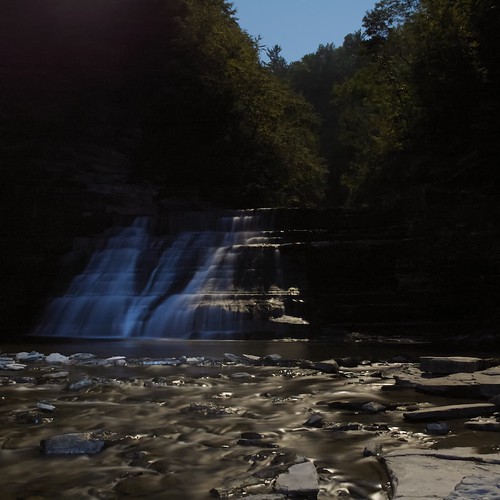
© 2010 Simon Hucko
After the sun goes down, you're probably not thinking about going out to photograph landscapes. However, the moon puts off a surprising amount of light, especially when it's close to full. You're still looking at several minute exposures, but you can get some interesting lighting (and some surprisingly blue skies) if you have a tripod and the patience to explore.
Another nice side effect of shooting at night is that it's much easier to add your own light to a scene. Something as simple as a flashlight can help you define important parts of your landscape. This technique is known as light painting. The idea is to use light selectively on portions of the image during a long exposure.
The photo above was just shy of 2 minutes at f/8, ISO 800. I used a LED flashlight to paint in the waterfall, ensuring that it would show in the photo with the relatively brighter moonlit rocks in the foreground. The high ISO and long exposure led to a bunch of noise (including some magenta fringing in one corner of the sensor). Some creative cropping, noise reduction and some selective desaturation resulted in a very usable image. If I did it again I would have opened the aperture up a stop or two and used a shorter exposure. This would have made my little flashlight effectively brighter (more on that some other time), helping the waterfall pop.
If you don't have one, I really recommend a little LED flashlight for your bag. They're cheap, bright, more or less daylight balanced (generally a little cooler), and can be used for many different things (light painting, finding your way/gear in the dark, focusing in low light when using flash, etc.)
Light painting was fun. It's probably not a technique I'll use often, but it was interesting to experiment with. What new techniques have you tried lately?
~S
[title of blog] on flickr
![[title of blog]](https://blogger.googleusercontent.com/img/b/R29vZ2xl/AVvXsEhJ8bvx_9_zOAREbXcrJRML7aVvJMbb90IYYYuyti384jeZHYQ9t8MK6_Kpt_1P4-pZw-QfF9kh4Sqci0vbopzLme862PPhuyPJcc7pRLUW1K1aNzts5YzuXIhgonq66MpjJCqfiWtfwUw/s1600-r/waterfall.png)




Nothing this cool! Very nice effect.
ReplyDelete